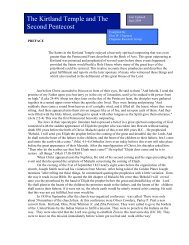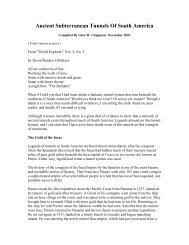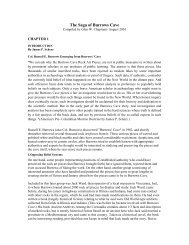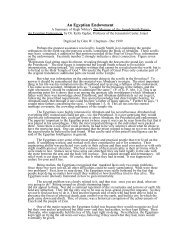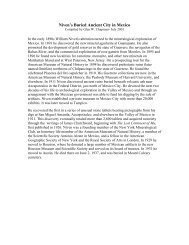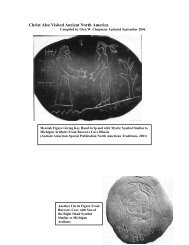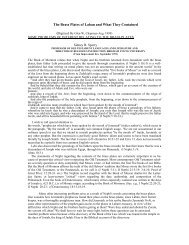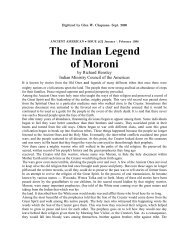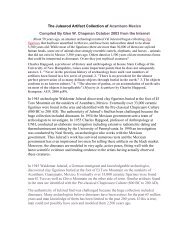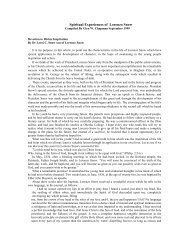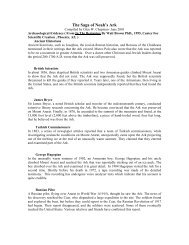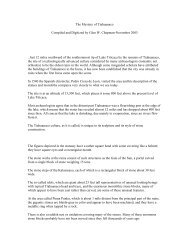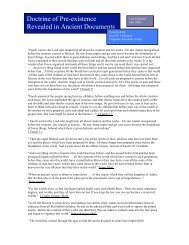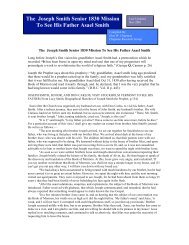Book of Mormon Evidences From Ancient Aztec and Mayan Writings
Book of Mormon Evidences From Ancient Aztec and Mayan Writings
Book of Mormon Evidences From Ancient Aztec and Mayan Writings
You also want an ePaper? Increase the reach of your titles
YUMPU automatically turns print PDFs into web optimized ePapers that Google loves.
When the news <strong>of</strong> Cortés’s exploits in Mexico suddenly burst upon the world in 1519, man inEurope had almost forgotten the very existence <strong>of</strong> an America. This was underst<strong>and</strong>able.During the years that had passed since its discovery America had provided only false hopes.Europeans dismissed “America” as yet one more instance <strong>of</strong> Spanishbraggadocio—until there arrived in Seville, on December 9, 1519, the first treasure ship fromMexico.Its arrival caused a tremendous sensation. Cortés had sent four fantastically attiredTotonacs from the Mexican coast to accompany the treasures, <strong>and</strong> in the golden cache there werebells <strong>and</strong> jewels, earrings <strong>and</strong> nose ornaments <strong>of</strong> exquisite workmanship, <strong>and</strong> leather ornamentsmounted in jewels, <strong>and</strong> there were even “books such as the use."The Italian humanist Pietro Martire D’Anghiera could not say enough about “the twobooks such as the Indians use.” He remained “wrapped in astonishment,” for to him thc “books”were a greater index to the quality this new civilization than the gold. “The Indians <strong>of</strong> the goldenl<strong>and</strong> write in books," he said in his letters to other humanists as he analyzed the technique <strong>of</strong> thehook <strong>and</strong> .hieroglyphics“. . . which almost resemble those <strong>of</strong> the Egyptians. . . among the figures<strong>of</strong> men <strong>and</strong> animals are those <strong>of</strong> kings <strong>and</strong> great lords ... so it may be presumed that they madereport <strong>of</strong> each one’s deeds …"Unfortunately, while the learned debated the <strong>Aztec</strong> civilization, speculating as to itsorigin, it was already being overwhelmed <strong>and</strong> destroyed. Thous<strong>and</strong>s more <strong>of</strong> these golden <strong>Aztec</strong>objects, brought to the king as his royal fifth, were melted down <strong>and</strong> minted into coin to pay <strong>of</strong>fhis immense debts incurred by European wars. As for other <strong>Aztec</strong> “books,” <strong>and</strong> exquisitely madegolden ornaments, these as well as other objects <strong>of</strong> <strong>Aztec</strong> culture perished in the Conquest.The <strong>Aztec</strong>s, whose writing was less developed than that <strong>of</strong> the Mayas, kept precise accounts<strong>of</strong> tribute <strong>and</strong> income, maps <strong>of</strong> property <strong>and</strong> detailed maps <strong>of</strong> Tenochtitlan.. We know theCorrect Sucession <strong>of</strong> their leaders <strong>and</strong> the names <strong>of</strong> all the ancient <strong>Aztec</strong> towns <strong>and</strong> provinces.(The <strong>Aztec</strong>s also left behind impressive literature, winch was set down by <strong>Aztec</strong>-Spanishscribes in the sixteenth century) Among the Mayas, we do not even know the names <strong>of</strong> theirkings.. Young Bernal Diaz in a Totonac temple at Cempoala, saw many paper booksdoubled together in. folds. No intellectual in Europe ever saw a Maya "book,” <strong>and</strong> since therewas little or no gold to act as stimulant, the learned <strong>of</strong> Europe never had any communicationabout those marvelously contrived stone cities which the Mayas had built. This was not the fault<strong>of</strong> the participators in conquest nor the priests nor the administrators who followed. Theypenned voluminous reports which went unpublished.A Spaniard who saw the Itzás’ hooks in 1697 gave a fully accurate account <strong>of</strong>their size <strong>and</strong> appearance: "<strong>Book</strong>s <strong>of</strong> a quarter <strong>of</strong> a yard high <strong>and</strong> about five fingers in width,made <strong>of</strong> the bark <strong>of</strong> trees, they are folded from side to side to another like screens. These arepainted on both sides.” The physical appearance <strong>of</strong> the three surviving Maya books, in particularthe Dresden Codex, fits this description. It is made from a single piece <strong>of</strong>’ bark paper beaten fromthe fibers <strong>of</strong> the copo..The Dresden Codex has thirty nine leaves painted on both sides, or seventy-eight pages.These pages are the "folds <strong>of</strong> the katun,” <strong>of</strong> which the codices speak. The Maya priest—scribesworked with brushes made from bristles <strong>of</strong> the wil pig. The colors used were dark red, light red,black, blue, yellow, brown, green, <strong>and</strong> lustrous black.Seventy years after the conquest <strong>and</strong> the burning <strong>of</strong> the books, a Spaniard still spoke <strong>of</strong>seeing "books" painted in color "giving the count <strong>of</strong> their years, the wars, epidemics, hurricanes,inundations, famines <strong>and</strong> other events." And as late as 1697 an isolated Itza chieftain knew allabout the history <strong>of</strong> Yucatan because "he had read it in his books." It has been stated that "theirhieroglyphic literature seems to have covered nearly every branch <strong>of</strong> Maya science." But thereare no examples <strong>of</strong> it. That they regarded their books as most sacred is shown by L<strong>and</strong>a'sremark, " the most important possession that the nobles who ab<strong>and</strong>oned Mayapan took to theirown province eas the books <strong>of</strong> their sciences"



